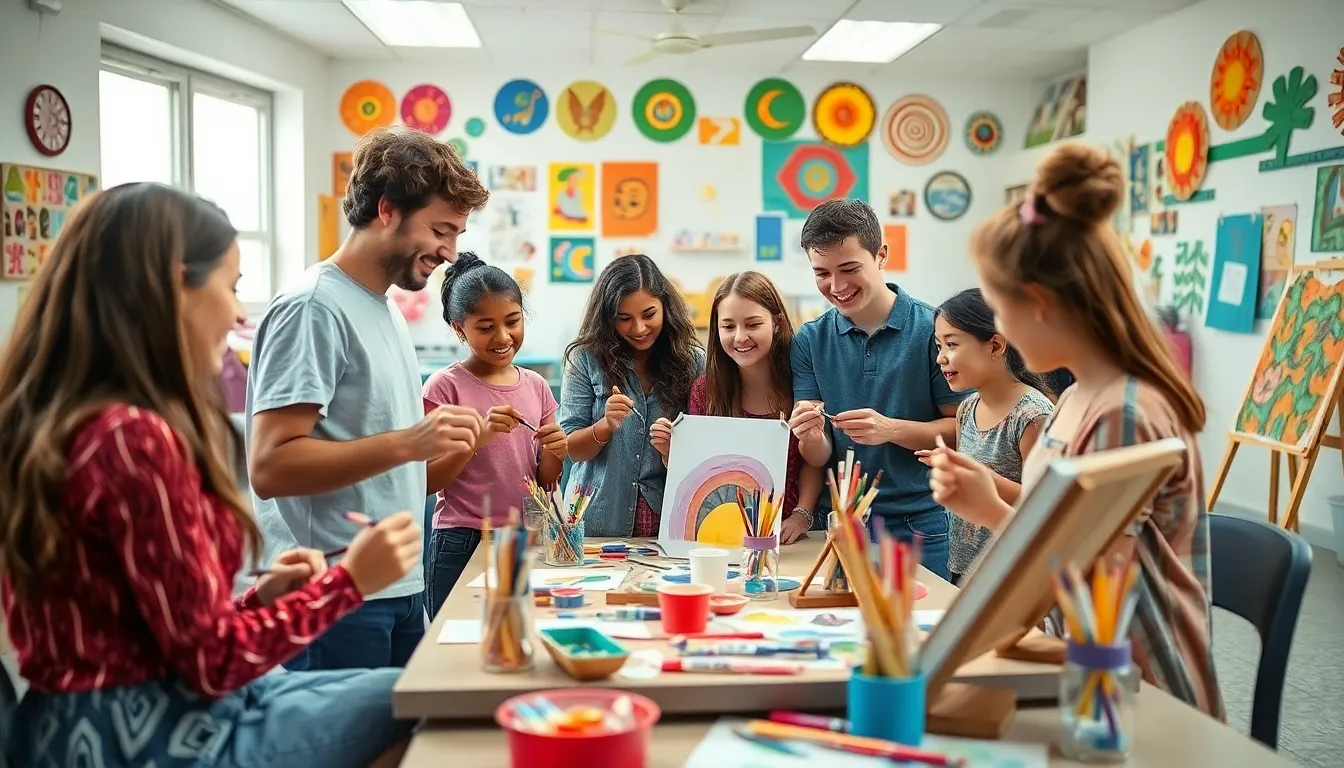In a world dominated by STEM, it’s easy to overlook the colorful world of art in education. But let’s face it: who wants to live in a monochrome society? Integrating art into the curriculum isn’t just about painting pretty pictures; it’s about fostering creativity, critical thinking, and problem-solving skills. After all, a well-rounded education is like a balanced diet—variety is key!
Imagine a classroom where students express their thoughts through vibrant colors and imaginative designs. They’re not just learning facts; they’re learning to think outside the box. Art encourages collaboration and communication, making learning a delightful adventure rather than a tedious chore. So why not embrace the brush and the canvas? It’s time to recognize that art isn’t just an extra; it’s an essential ingredient in the recipe for a successful education.
Table of Contents
ToggleOverview of Art in Education
Art in education plays a crucial role in developing critical skills. Integrating artistic activities within curricula cultivates creativity in students. Engaging in art encourages innovative thinking and enhances problem-solving abilities. Research indicates that students exposed to art exhibit higher levels of academic achievement, particularly in subjects like mathematics and science.
Collaboration often flourishes in art-based learning environments. Group projects involving artistic creation necessitate communication and teamwork. Students share ideas, brainstorm solutions, and provide feedback, fostering a supportive culture. By participating in these collective artistic endeavors, students sharpen their interpersonal skills and increase their engagement.
In addition to creativity and collaboration, art enhances emotional expression. Exposure to diverse artistic methods allows students to articulate their feelings and ideas. They explore different perspectives, experiencing art as both a personal and shared journey. By emphasizing empathy through art, educators promote understanding and acceptance among peers.
An essential aspect of art in education is its ability to boost confidence. Students gain self-assurance as they experiment with various artistic forms. Completing a challenging project instills a sense of achievement. This accomplishment translates into a positive self-image and encourages students to take risks in other academic areas.
Educational institutions benefit from incorporating art as well. Schools that prioritize art programs often see an enriched school culture. A diverse range of creative offerings can attract families and increase student enrollment. Investing in arts education signifies a commitment to developing well-rounded, capable individuals prepared for future challenges.
Importance of Art in Education

Art in education serves as a crucial element for holistic student development. Integrating art enhances learning experiences, making education more engaging and impactful.
Benefits for Cognitive Development
Art contributes significantly to cognitive development by stimulating critical thinking. Students exposed to artistic practices often demonstrate improved problem-solving skills. Research shows that engagement in the arts correlates with higher performance in subjects like mathematics and science. Cognitive processes involved in creating art foster analytical thinking and enhance focus. Learning through art also encourages students to connect concepts across various subjects, strengthening their overall academic performance. Exposure to diverse art forms broadens perspectives, further contributing to cognitive growth.
Enhancing Creativity and Innovation
Art fosters creativity and innovation, essential skills in today’s rapidly changing world. Engaging in artistic activities encourages students to think outside the box. They learn to approach challenges with fresh ideas and explore multiple solutions. Collaborative art projects often lead to innovative outcomes, as group dynamics stimulate creativity. Furthermore, art enables students to express their individuality, cultivating a sense of uniqueness and originality. Educational environments that prioritize art often produce more creative thinkers, better equipped to navigate future challenges.
Different Forms of Art in Education
Art integrates in various forms, each contributing uniquely to educational experiences.
Visual Arts
Visual arts encompass disciplines such as painting, drawing, sculpture, and photography. Students express ideas and emotions through visual mediums, enhancing creativity and problem-solving skills. Engaging in visual arts cultivates observational skills that translate into better comprehension in other subjects. Research indicates that students exposed to visual arts show improved performance in mathematics and sciences. Notably, collaboration in visual art projects can lead to deeper understanding and communication among peers. Schools that emphasize visual arts programs enrich the overall educational framework and promote an inclusive and supportive environment.
Performing Arts
Performing arts include theater, music, and dance, providing students with avenues for expressiveness. Participation in these activities nurtures team dynamics, as many projects rely on collaboration among participants. These experiences foster public speaking skills, enhancing confidence and engagement. Research shows that students involved in performing arts excel academically and socially, benefiting from the discipline required in rehearsals and performances. Additionally, performing arts offer emotional outlets, helping students process feelings and experiences. Schools prioritizing performing arts create vibrant cultures, attracting families and fostering community engagement.
Digital Arts
Digital arts combine technology with creativity, encompassing graphic design, animation, and digital photography. Students develop technological proficiency, essential skills in today’s digital landscape. Exploration of digital arts encourages innovative thinking, pushing students to experiment with various styles and techniques. Collaboration on digital projects fosters teamwork and enhances communication skills. With the growing importance of digital literacy, integrating digital arts into curricula equip students for future career opportunities. Schools that emphasize digital arts prepare students to navigate and contribute in a technology-driven world, enhancing their academic journeys and creative potential.
Challenges in Integrating Art in Education
Integrating art in education comes with various challenges that schools must address. Budget constraints often limit the resources available for art programs, impacting the quality and frequency of art classes. Many institutions prioritize core subjects, leaving little funding for creative disciplines. Schools facing budget limitations might struggle to hire qualified art teachers or provide necessary materials.
Balancing curriculum requirements presents another challenge. Educators frequently feel pressure to cover standardized tests and core content areas. As a result, art programs might receive less attention and time than they deserve. It’s crucial for schools to realize that integrating art can enhance overall learning. Effective strategies may include incorporating art projects into core subjects, ensuring a well-rounded educational experience that nurtures creativity and critical thinking.
Successful Case Studies
Several educational institutions have effectively integrated art into their curricula, demonstrating the profound impact of this integration on student development. The Denver School of the Arts excels in combining rigorous academics with extensive arts training, producing well-rounded students who consistently outperform their peers in standardized testing. Multiple studies indicate that students involved in arts programs achieve higher grades in subjects like mathematics and science, reinforcing the cognitive benefits of artistic engagement.
Another example includes the Long Island School of the Arts, where students showcase their work not only in galleries but also during exhibitions. These experiences foster critical skills like teamwork and communication, creating a culture of support among students. Engagement in group projects leads to collaboration, essential for addressing today’s complex challenges.
In the Chicago Public Schools system, art programs have reportedly decreased dropout rates, illustrating the emotional and social benefits of arts education. Students develop confidence through successful completion of challenging artistic projects. Performing arts initiatives provide outlets for self-expression, helping students articulate feelings while promoting empathy among diverse peers.
Additionally, the Boston Arts Academy integrates digital arts into its curriculum, preparing students for future careers. This approach enhances innovative thinking and nurtures problem-solving skills. Their interdisciplinary projects connect art with core subjects, ensuring that students not only learn creatively but also strengthen their academic performance.
Research consistently shows that when schools prioritize art education, they cultivate vibrant, culturally rich environments, attracting families seeking holistic education. Educators can implement effective strategies, such as incorporating art into science lessons or mathematics, to support a balanced curriculum that nurtures creativity and critical thinking. Schools that invest in art programs contribute to developing well-rounded individuals equipped to navigate future challenges.
Integrating art into education is vital for fostering a comprehensive learning environment. It cultivates creativity and critical thinking while enhancing emotional expression and teamwork. Students who engage in artistic activities not only develop essential skills but also gain confidence that translates into other academic areas.
Educational institutions that prioritize art create vibrant cultures that attract families and support well-rounded development. By recognizing the significance of art in education and implementing effective strategies, schools can overcome challenges and enrich students’ academic journeys. Ultimately, a commitment to art education prepares students to navigate an increasingly complex world with innovation and empathy.



